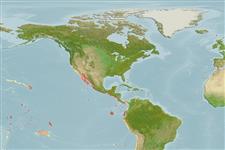Teleostei (teleosts) >
Tetraodontiformes (Puffers and filefishes) >
Balistidae (Triggerfishes)
Etymology: Balistes: Latin, balista, -ae = crossbowman. In Greek, ballo = to throw (Ref. 45335).
More on author: Steindachner.
Environment: milieu / climate zone / depth range / distribution range
Ecology
Marine; reef-associated; depth range 3 - 60 m (Ref. 91172). Subtropical; 38°N - 30°S, 180°W - 70°W
Eastern Pacific from northern California to Chile and Hawaiian Islands; including the Galapagos Islands.
Size / Weight / Age
Maturity: Lm ? range ? - ? cm
Max length : 76.0 cm TL male/unsexed; (Ref. 2850); common length : 50.0 cm TL male/unsexed; (Ref. 9276)
Body compressed and deep; skin thick, with large, rectilinear, plate-like scales that are easily visible to the naked eye; mouth small; teeth strong and protruding, 8 in each jaw; dorsal fin with 3 spines and 26 to 28 rays; scales behind the gill openings larger than the neighboring scales; snout surrounded by scales (Ref. 55763).
Occurs in rocky reefs, boulder strewn slopes and adjacent areas of sand. Adults demersal; young pelagic (Ref. 2850). Feeds on sea urchins, small crustaceans and mollusks (Ref. 5227). Minimum depth 3m (Ref. 116844).
Life cycle and mating behavior
Maturity | Reproduction | Spawning | Eggs | Fecundity | Larvae
Eschmeyer, W.N., E.S. Herald and H. Hammann, 1983. A field guide to Pacific coast fishes of North America. Boston (MA, USA): Houghton Mifflin Company. xii+336 p. (Ref. 2850)
IUCN Red List Status (Ref. 130435: Version 2024-1)
Threat to humans
Harmless
Human uses
Fisheries: commercial
Tools
Special reports
Download XML
Internet sources
Estimates based on models
Preferred temperature (Ref.
123201): 19.2 - 28.9, mean 25.8 °C (based on 76 cells).
Phylogenetic diversity index (Ref.
82804): PD
50 = 0.5078 [Uniqueness, from 0.5 = low to 2.0 = high].
Bayesian length-weight: a=0.02754 (0.01746 - 0.04345), b=2.84 (2.71 - 2.97), in cm total length, based on LWR estimates for this species & (Sub)family-body (Ref.
93245).
Trophic level (Ref.
69278): 3.3 ±0.37 se; based on food items.
Generation time: 6.5 ( na - na) years. Estimated as median ln(3)/K based on 1
growth studies.
Resilience (Ref.
120179): Low, minimum population doubling time 4.5 - 14 years (Preliminary K or Fecundity.).
Fishing Vulnerability (Ref.
59153): Moderate to high vulnerability (54 of 100).
Nutrients (Ref.
124155): Calcium = 15.3 [5.8, 48.1] mg/100g; Iron = 0.482 [0.239, 1.121] mg/100g; Protein = 19.3 [18.1, 20.5] %; Omega3 = 0.169 [0.108, 0.270] g/100g; Selenium = 21.1 [8.4, 45.9] μg/100g; VitaminA = 23.3 [5.9, 98.5] μg/100g; Zinc = 0.596 [0.382, 0.939] mg/100g (wet weight);
